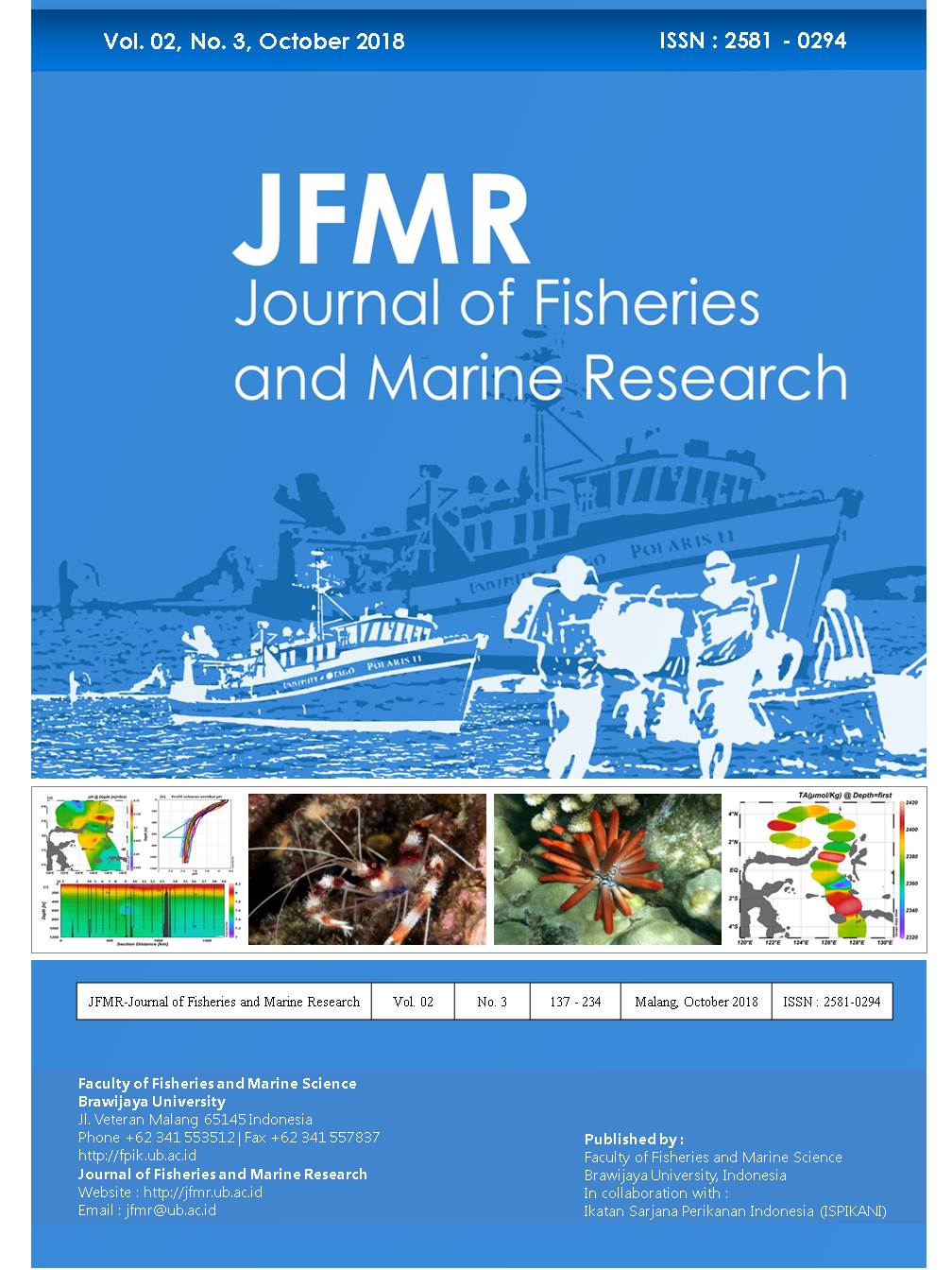EFFECT OF CHITOSAN COATINGS ON PRESERVATION OF RED SNAPPER (Lutjanus argentimaculatus Forsskal, 1775 ) DURING LOW TEMPERATURE STORAGE
DOI:
https://doi.org/10.21776/ub.jfmr.2018.002.03.5Abstract
The effect of three different concentration of chitosan (0, 1.5 and 2 % w/v) on microbiological (aerobic plate count), chemicals (pH and total volatile basic nitrogen, TVB-N), and sensory properties of red snapper (Lutjanus argentimaculatus Forsskal, 1775) during cold storage (4-7oC) was evaluated periodically. The microbiological quality of red snapper coated with chitosan was lower compared to control, whereas pH and TVB-N were lower when treated with chitosan. The overall score of sensory evaluation of chitosan with concentration of 1% (w/v) was higher compared to remaining treatments. This study indicates that coating of chitosan prior to storage and distribution of red snapper prolong the shelf life of the fish but the microbial quality during storage is depend on initial quality of the fish.Â
References
AOAC. 2002. Officialmethods of analysis.Association of Official Analytical Chemists International. 17thEd., Ch.17, Vol.1., p.4-5, 52., Gaithersburg, USA.
Cao, Rong., Xue, Chang-Hu., Liu Xu.2009. Changes in microbial flora of Pacific oysters (Crassostrea gigas) during refrigerated storage and its shelf-life extension by chitosan. International Journal of Food microbiology 131 (2009) 272–276
Choi, E. J., Park, H., Chung Y. B., Park, S. H. Kim, J. S., And Chun, K. (2017) Effect Of Tempering Methods On Quality Changes Of Pork Loin Frozen By Cryogenic Immersion. Meat Science 124 : 69–76
Connel, J.J. (1990). Control of Fish Quality, 3rd ed. Fishing News (Book) Ltd., London.
Damayanti, Windi., Rochima, Emma., Hasan, Zahidah. 2016. Application of Chitosan as Antibacterial for Pangasius Fillet at Low Temperature Storage. Faculty of Fisheries and Marine Sciences Padjadjaran University.Indonesian Fisheries Processing Journal Vol 19:3
Fan, Wenjiao., Sun, Junxiu., Chen, Yunchuan., Qiu, Jian., Zhang, Yan., Chi, Yuanlong. 2009. Effects of chitosan coating on quality and shelf life of silver carp during frozen storage. Food Chemistry 115 66–70
Ma, j., alendro, g., kwangcheol, c. j. (2017) Application, mode of action, and in vivo activity of chitosan and its microandnanoparticles as antimicrobial agents: A review. Carbohydrate Polymers 176: 257–265
Solo-de-ZaldÃvar, C.A. Tovar, A.J. BorderÃas, B. Herranz. 2015. Pasteurization and chilled storage of restructured fish muscle products based on glucomannan gelation. Journal of Food Hydrocolloids:115:66-70
Tsai,G.J.,W.H.Su.H.C.Chen.and C.L.Pan.2002. Antimicrobial activity of shrimp chitosan from different treatments and applications of fish preservation. Fisheries Science 70:675-681
Xavier, K.A. Martin., Hauzoukim., Kannuchamy, Nagalakshmi., K. Balange, Amjad., Choukseya, M.K..,Gudipati,Venkateshwarlu. Functionality of chitosan in batter formulations for coating of fish sticks: Effect on physicochemical quality
Zhang, L., Luo, Y., Hu, S., & Shen, H. 2012. Effects of chitosan coatings enriched with different antioxidants on preservation of grass carp (Ctenopharyngodon idellus) during cold storage. Journal of Aquatic Food Product Technology: 21: 508-518
Downloads
Published
Issue
Section
License
Submission of a manuscript implies: that the work described has not been published before (except in the form of an abstract or as part of a published lecture, or thesis) that it is not under consideration for publication elsewhere; that if and when the manuscript is accepted for publication, the authors agree to automatic transfer of the copyright to the publisher.















